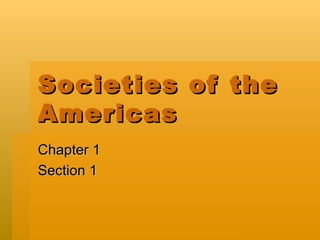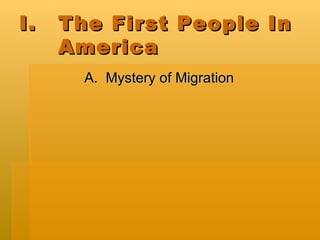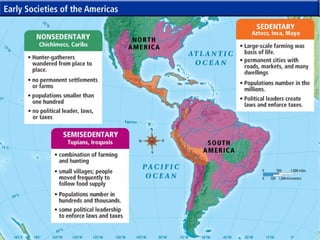Ch 1 Sec 1; Societies Of The Americas
- 1. Societies of the Americas Chapter 1 Section 1
- 2. The First People In America Mystery of Migration
- 3. Migration To The Americas (1:13)
- 4. II. The Rise of Civilizations The Growth of Complex Societies Early Civilizations Fall
- 5. Ěý
- 6. Comparing Societies No political leaders, laws, or taxes Some political leaders to enforce laws, taxes Political leaders enforce laws, taxes Government <100 >100<10,000 >1,000,000 Population No permanent settlement Small villages Large cities Settlements Hunter-gatherers Farming and hunting Large-scale farming Food Nonsedentary Semisedentary Sedentary
- 7. The Rise and Fall of the Aztec (6:04)
- 8. The Inca Empire (2:55)
- 9. The Anasazi Pueblo Bonito (5:45)
- 10. Early Native American Life Animated History What does this image fo the market and its environment tell you about the size and culture of Tenochitlán? How did merchants bring their goods to market? Why do you think the Aztecs built their capital city on an island? How are Tenochitlán and Mexico city alike?
- 11. Journal Entry Suppose (imagine) that you have entered Tenochitlán for the first time. Write a first-hand account of your impressions. Include the following: How you got there What you see What impressed you the most
- 12. Chapter 1 Section 1 Assessment Essential Question: Which type of society, sedentary, semi-sedentary, or non-sedentary, was the most advantageous? What were the methods of providing food for the society? What relationships did each society type have with their neighbors? How did each society interact with the natural environment? What types of rules and leaders did each group have? Sedentary Semi-sedentary Non-sedentary
- 13. Introduction/Hook Conclusion Evidence #1 + Analysis Evidence #2 + Analysis Critical Claim Paragraph Structure
- 14. Introduction: simple and direct openings are best A direct statement of fact Ěý Ěý A statement intended to startle the reader with its bluntness or frankness: STRONG OPINION A question or series of questions Tell a real story Introduction HOOK
- 15. Introduction: simple and direct openings are best A direct statement of fact: "I underwent, during the summer I became fourteen, a profound religious crisis." --James Baldwin, "Letter from a Region in My Mind." Ěý Ěý A statement intended to startle the reader with its bluntness or frankness: "Lie detectors lie." --Jonathan Kwitney, "The Dirty Little Secret of Lie Detectors." Ěý Ěý Introduction
- 16. Introduction: simple and direct openings are best A question or series of questions : "How does the mind work? To answer that question we must look at some of the work performed by the mind." --Noam Chomsky, "Language and the Mind." Ěý Ěý An authentic illustrative anecdote: "Someone said recently to an old black lady from Mississippi, whose legs had been badly mangled by local police who arrested her for 'disturbing the peace,' that the civil rights movement was dead, and asked, since it was dead what she thought about it. The old lady replied, hobbling out of his presence on her cane, that the civil rights movement was like herself, 'if it's dead it shore ain't ready to lay down!'" --Alice Walker, "The Civil Rights Movement: What Good Was It?" Introduction
- 17. Critical Claim Take a clear position Give at least two reasons or evidence to support your position Example: ________ society is the most advantageous because ________ and ___________. Introduction Critical Claim
- 18. Critical Claim The Japanese subway is __________ because __________ and _________.
- 19. Evidence + Analysis Evidence Facts that support your claim. Analysis Helps the reader understand the evidence. “ This is important because….” Evidence #1 + Analysis Evidence #2 + Analysis
- 20. Strategies for writing effective conclusions Make a useful analogy or comparison . Ěý Ěý Suggest actions that the reader should take . Speculate about future implications . Sum up your feelings . Conclusion
- 21. Ěý
- 22. Ěý
- 23. Ěý
- 24. Ěý
- 25. Ěý
- 26. Introduction/Hook Conclusion Evidence #1 + Analysis Evidence #2 + Analysis Critical Claim Paragraph Structure Essential Question: Which type of society, sedentary, semi-sedentary, or non-sedentary, was the most advantageous?

























